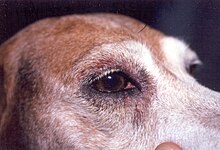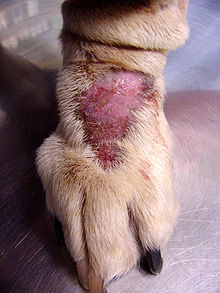Dog skin disorders are among the most common health problems in dogs.
Skin disorders in dogs have many causes, and many of the common skin
disorders that afflict people have a counterpart in dogs. The condition
of dog's skin and coat can also be an important indicator of its general
health. Skin disorders of dogs vary from acute, self-limiting
problems to chronic or long-lasting problems requiring life-time treatment. They also need to be differentiated on the basis of being of primary or secondary (due to scratching, itch) in nature, making diagnosis complicated.[1] Dog skin disorders may be grouped into categories according to the causes.

Some of the allergens associated with canine AD include pollens of trees, grasses and weeds, as well as molds and House dust mite. Ear and skin infections with the bacteria Staphylococcus pseudintermedius and the yeast Malassezia pachydermatis are common secondary to canine AD. Flea allergy is commonly associated with AD. AD is a lifelong condition in most dogs.
Food allergy can be associated with identical signs and some authorities consider food allergy to be a type of atopic dermatitis.

Diagnosis of AD is by elimination of other causes of irritation including fleas, scabies and other parasites such as Cheyletiella and lice. Food allergy can be identified through the use of elimination diet trials in which a novel or hydrolysed protein diet is used for a minimum of 6 weeks and allergies to aeroallergens can be identified using intradermal allergy testing and/or blood testing (allergen-specific IgE ELISA).
Treatment for AD includes avoidance of the offending allergens if possible, but for most dogs this is not practical or effective. Other treatments modulate the adverse immune response to allergens and include antihistamines, steroids, ciclosporin and immunotherapy (a process in which allergens are injected to try to induce tolerance).[5] In many cases shampoos, medicated wipes and ear cleaners are needed to try to prevent the return of infections.

New research into T-cell receptor peptides and their effects on dogs with severe, advanced atopic dermatitis are being investigated by Animal Health Consulting, LLC.

Treatment of autoimmune skin conditions requires treatment to markedly reduce the abnormal immune response; steroids, azathoprine and other drugs are used as immunosuppressive agents.
Related to Hot Spots are Lick granulomas, a raised, usually ulcerated area on a dog's wrist or ankle area caused by the dog's own incessant compulsive
licking. According to the Merck Manual of Veterinary Medicine,
compulsive licking has the following necessary condition: licking in
excess of that required for standard grooming or exploration. The
following condition is sufficient: licking in excess of that required
for grooming or exploration that represents a change in the animal’s
typical behavior and interferes with other activities or functions
(e.g., eating, drinking, playing, interacting with people) and cannot
easily be interrupted.[6]
Infectious skin diseases of dogs include contagious and
non-contagious infections or infestations. Contagious infections include
parasitic, bacterial, fungal and viral skin diseases.
One of the most common contagious parasitic skin diseases is Sarcoptic canine scabies. Another is mange caused by Demodex (Demodicosis), though this form of mange is not contagious. Another contagious infestation is caused by a mite, Cheyletiella. Dogs can be infested with contagious lice.
Other ectoparasites, including flea and tick infestations are not considered directly contagious but are acquired from an environment where other infested hosts have established the parasite's life cycle.
Ringworm is a fungal skin infection and is more common in puppies than in adult dogs.
Non-contagious skin infections can result when normal bacterial or fungal skin flora is allowed to proliferate and cause skin disease. Common examples in dogs include Staphylococcus intermedius pyoderma, and Malassezia dermatitis caused by overgrowth of Malassezia pachydermatis.

Puppy strangles is a developmental skin disease of puppies of unknown etiology.

problems to chronic or long-lasting problems requiring life-time treatment. They also need to be differentiated on the basis of being of primary or secondary (due to scratching, itch) in nature, making diagnosis complicated.[1] Dog skin disorders may be grouped into categories according to the causes.
Types of disorder
Immune-mediated skin disorders
Skin disease may result from deficiency or overactivity of immune responses. In cases where there is insufficient immune responses the disease is usually described by the secondary disease that results. Examples include increased susceptibility to demodectic mange and recurrent skin infections, such as Malassezia infection or bacterial infections. Increased, but harmful immune responses, can be divided into hypersensitivity disorders such as atopic dermatitis, and autoimmune disorders (autoimmunity), such as pemphigus and discoid lupus erythematosus.- Canine Atopic Dermatitis
Some of the allergens associated with canine AD include pollens of trees, grasses and weeds, as well as molds and House dust mite. Ear and skin infections with the bacteria Staphylococcus pseudintermedius and the yeast Malassezia pachydermatis are common secondary to canine AD. Flea allergy is commonly associated with AD. AD is a lifelong condition in most dogs.
Food allergy can be associated with identical signs and some authorities consider food allergy to be a type of atopic dermatitis.
Diagnosis of AD is by elimination of other causes of irritation including fleas, scabies and other parasites such as Cheyletiella and lice. Food allergy can be identified through the use of elimination diet trials in which a novel or hydrolysed protein diet is used for a minimum of 6 weeks and allergies to aeroallergens can be identified using intradermal allergy testing and/or blood testing (allergen-specific IgE ELISA).
Treatment for AD includes avoidance of the offending allergens if possible, but for most dogs this is not practical or effective. Other treatments modulate the adverse immune response to allergens and include antihistamines, steroids, ciclosporin and immunotherapy (a process in which allergens are injected to try to induce tolerance).[5] In many cases shampoos, medicated wipes and ear cleaners are needed to try to prevent the return of infections.
New research into T-cell receptor peptides and their effects on dogs with severe, advanced atopic dermatitis are being investigated by Animal Health Consulting, LLC.
- Autoimmune skin diseases
Treatment of autoimmune skin conditions requires treatment to markedly reduce the abnormal immune response; steroids, azathoprine and other drugs are used as immunosuppressive agents.
Physical and environmental skin diseases
- Hot Spots
- Acral lick granulomas
Infectious skin diseases
One of the most common contagious parasitic skin diseases is Sarcoptic canine scabies. Another is mange caused by Demodex (Demodicosis), though this form of mange is not contagious. Another contagious infestation is caused by a mite, Cheyletiella. Dogs can be infested with contagious lice.
Other ectoparasites, including flea and tick infestations are not considered directly contagious but are acquired from an environment where other infested hosts have established the parasite's life cycle.
Ringworm is a fungal skin infection and is more common in puppies than in adult dogs.
Non-contagious skin infections can result when normal bacterial or fungal skin flora is allowed to proliferate and cause skin disease. Common examples in dogs include Staphylococcus intermedius pyoderma, and Malassezia dermatitis caused by overgrowth of Malassezia pachydermatis.
Hereditary and developmental skin diseases
Some diseases are inherent abnormalities of skin structure or function. These include seborrheic dermatitis, ichthyosis, skin fragility syndrome (Ehlers-Danlos), hereditary canine follicular dysplasia and hypotrichosis, such as color dilution alopecia.Puppy strangles is a developmental skin disease of puppies of unknown etiology.

















technologies etc, there is always a chance of new vacancies emerging. A healthcare recruiter must stay abreast with the latest developments in the industry for hiring the best possible candidates available in the region.
ReplyDeleteclick here